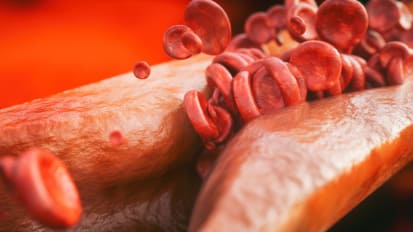8th Annual Update on Vascular Disease
Release Date: December 1, 2017
Expiration Date: November 30, 2020
Estimated Time of Completion: This activity is expected to take approximately 1.25 hours to complete.
Program Agenda
Central Venous Obstruction: Clinical Signs, Evaluation and Treatment
Expiration Date: November 30, 2020Critical Limb Ischemia: Open Bypass or Endovascular Treatment
Expiration Date: November 30, 2020Faculty
Vikram Kashyap, MD
Activity Director
Chief, Division of Vascular Surgery and Endovascular Therapy
UH Cleveland Medical Center
Co-Chair, Clinical Executive Executive Committee
Director, Vascular Center
UH Harrington Heart & Vascular Institute
Professor of Surgery
Case Western Reserve University School of Medicine
Dr. Kashyap has received honoraria from Silk Road Medical for proctoring surgical cases, and the CME Program has determined there is no conflict of interest.
Michael Brown, DO
Vascular Surgery and Endovascular Therapy
UH Harrington Heart & Vascular Institute
Clinical Assistant Professor of Surgery
Case Western Reserve University School of Medicine
Dr. Brown reports no financial relationship with a commercial interest relevant to this activity.
Norman Kumins, MD
Vascular Surgery and Endovascular Therapy
UH Harrington Heart & Vascular Institute
Clinical Assistant Professor of Surgery
Case Western Reserve University School of Medicine
Dr. Kumins reports no financial relationship with a commercial interest relevant to this activity.
Cathy Sila, MD
Director, Stroke Center
UH Neurological Institute
Vice Chairman, Department of neurology
Program Director, Vascular Neurology
UH Cleveland Medical Center
Professor of Neurology
Case Western Reserve University School of Medicine
Dr. Sila reports no financial relationship with a commercial interest relevant to this activity.
Media
Recorded slides and audio presentation. Supplementary educational materials may include downloads of videos, print materials, slides or web pages.Target Audience
This program is intended to update practicing internists, family medicine physicians, primary care physicians, cardiologists, cardiac surgeons, vascular surgeons, physician assistants, nurse practitioners, nurses, residents and fellows on current topics in cardiovascular disease.
Learning Objectives
After participating in this activity, participants will be able to:
- Identify clinical signs and symptoms of venous obstruction including the CEAP classification
- Discuss guideline-based recommendations for the treatment of carotid stenosis
- Describe the risks and benefits of endarterectomy
- Discuss the pathophysiology of limb ischemia
- Evaluate the indications for open surgery vs. endovascular therapy
- Recognize evidence for thrombolysis for DVT/PE
- Conduct rapid evaluation /management of rAAA
- Describe medical and interventional treatments for claudication.
Accreditation Statement

Case Western Reserve University School of Medicine is accredited by the Accreditation Council for Continuing Medical Education to provide continuing medical education for physicians.
Case Western Reserve University School of Medicine designates this enduring material for a maximum of 1.25 AMA PRA Category 1 Credits™. Physicians should claim only the credit commensurate with the extent of their participation in the activity.
Planning Committee
Vikram Kashyap, MD
Dr. Kashyap has received honoraria from Silk Road Medical for proctoring surgical cases, and the CME Program has determined there is no conflict of interest.
Virginia Wong, MD
Dr. Wong reports no financial relationship with a commercial interest relevant to this activity.
Disclosure Statement
The policy of Case Western Reserve University School of Medicine CME Program (CWRU CME) requires that the Activity Director, planning committee members and all activity faculty (that is, anyone in a position to control the content of the education activity) disclose to the activity participants all relevant financial relationships with commercial interests. Where disclosures have been made, conflicts of interest, real or apparent, must be resolved. Disclosure will be made to activity participants prior to the commencement of the activity. CWRU CME also requires that faculty make clinical recommendations based on the best available scientific evidence and that faculty identify any discussion of "off-label" or investigational use of pharmaceutical products or medical devices.
Instructions
To receive a statement of credit for up to 1.25 AMA PRA Category 1 Credits™ you must:
- Review the full content of the recorded sessions available for credit.
- Review any supplementary materials referenced under Resources.
- Reflect on the content.
- Successfully complete the post-test. A score of 75% is required for passage.
- Complete the evaluation.
Your credits will be recorded by the CWRU School of Medicine CME Program and made a part of your cumulative transcript.
Fee
There is no fee for this program.
To contact the CME Provider: E-mail Case Western Reserve University School of Medicine CME at medcme@case.edu
Medical Disclaimer
Medicine is an ever-changing science. As new research and clinical experience broaden our knowledge, changes in treatment and drug therapy are required. The author has checked with sources believed to be reliable in their efforts to provide information that is complete and generally in accord with the standards accepted at the time of publication.
Although every effort is made to ensure that this material is accurate and up-to-date, it is provided for the convenience of the user and should not be considered definitive. Neither the author nor the Case School of Medicine nor any other party who has been involved in the preparation or publication of this work warrants that the information contained herein is in every respect accurate or complete, and they are not responsible for any errors or omissions or for the results obtained from the use of such information.
Learners are encouraged to confirm the information contained herein with other sources. This information should not be construed as personal medical advice and is not intended to replace medical advice offered by physicians. The Case School of Medicine will not be liable for any direct, indirect, consequential, special, exemplary, or other damages arising here from.
Resources
- Agarwal S, et al. Nationwide Trends of Hospital Admissions and Outcomes Among Critical Limb Ischemia Patients. JACC 2016;67(16):1901-13
- Patel MR et al. Evaluation and treatment of patients with lower extremity peripheral artery disease: consensus definitions from Peripheral Academic Research Consortium (PARC). JACC 2015;65:931-41
- Conte MS et al. Results of PREVENT III: A multicenter, randomized trial of edifoligide for the prevention of vein graft failure in lower extremity bypass surgery. JVS 2010;51:5S-17S
- Adam DJ et al. Bypass versus angioplasty in severe ischaemia of the leg (BASIL) Lancet 2005;366:1925-34
- Bradbury AW et al. Bypass versus angioplasty in severe ischaemia of the leg (BASIL) trial: An intention to treat analysis of amputation free and overall survival in patients randomized to a bypass surgery first or a balloon angioplasty first revascularization strategy. JVS 2010;51:5S-17S
- Chaturvedi, S., et al. "Carotid endarterectomy—An evidence-based review Report of the Therapeutics and Technology Assessment Subcommittee of the American Academy of Neurology." Neurology 65.6 (2005): 794-801.
- Johnston, D. C., & Goldstein, L. B. (2001). Clinical carotid endarterectomy decision making Noninvasive vascular imaging versus angiography. Neurology, 56(8), 1009-1015.
- Kumar, Anand, et al. "Pulmonary artery occlusion pressure and central venous pressure fail to predict ventricular filling volume, cardiac performance, or the response to volume infusion in normal subjects." Critical care medicine 32.3 (2004): 691-699.







